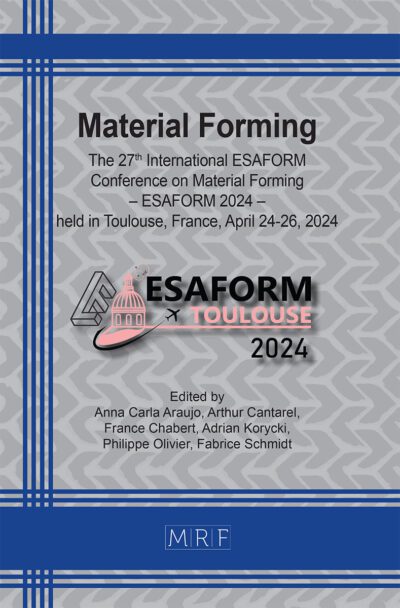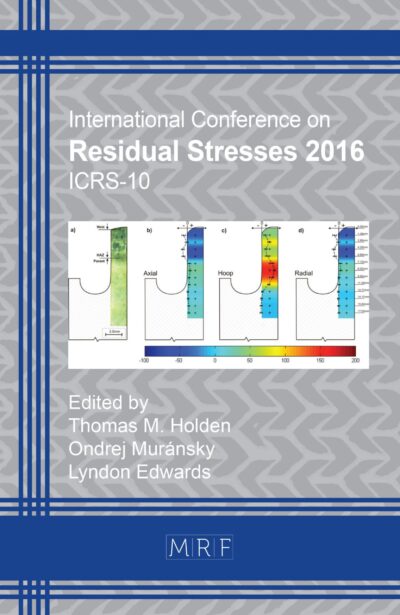Effect of hybrid tool surface technologies on the wear performance of thin sheet shearing punches
Mehmet Okan Görtan, Ahmet Celal Topkaya, Yağmur Bayraktar
Abstract. The gradual wear of materials leads to geometric changes in tools, which in turn affects the shape of parts in metal forming processes. As a result, enhancing the surfaces of forming tools to extend their lifespan remains an ongoing challenge. An innovative method to further boost surface hardness and deepen the hardened layer of metal forming tools involves applying severe shot peening (SSP) before nitriding. In the current study, effect of hardening, SSP, plasma nitriding as well as their combination on the tool life of shear cutting tools have been investigated.
Keywords
Hybrid Tool Surfaces, Tool Wear, Shot Peening, Plasma Nitrading
Published online 5/7/2025, 8 pages
Copyright © 2025 by the author(s)
Published under license by Materials Research Forum LLC., Millersville PA, USA
Citation: Mehmet Okan Görtan, Ahmet Celal Topkaya, Yağmur Bayraktar, Effect of hybrid tool surface technologies on the wear performance of thin sheet shearing punches, Materials Research Proceedings, Vol. 54, pp 1106-1105, 2025
DOI: https://doi.org/10.21741/9781644903599-120
The article was published as article 120 of the book Material Forming
![]() Content from this work may be used under the terms of the Creative Commons Attribution 3.0 license. Any further distribution of this work must maintain attribution to the author(s) and the title of the work, journal citation and DOI.
Content from this work may be used under the terms of the Creative Commons Attribution 3.0 license. Any further distribution of this work must maintain attribution to the author(s) and the title of the work, journal citation and DOI.
References
[1] J. Archard, Contact and rubbing of flat surfaces. J. Appl. Phys. 24-8 (1953) 981-988. https://doi.org/10.1063/1.1721448
[2] M. Hawryluk Review of selected methods of increasing the life of forging tools in hot die forging processes. ACME 16 (2016) 845-866. https://doi.org/10.1016/j.acme.2016.06.001
[3] M. Podgrajšek, S. Glodež, Z. Ren, Failure analysis of forging die insert protected with diffusion layer and PVD coating. Surf. Coat. Tech. 276 (2015) 521-528. https://doi.org/10.1016/j.surfcoat.2015.06.021
[4] I.F. Pariente, M. Guagliano, About the role of residual stresses and surface work hardening on fatigue ΔKth of a nitrided and shot peened low-alloy steel. Surf. Coat. Tech. 202-13 (2008) 3072-3080. https://doi.org/10.1016/j.surfcoat.2007.11.015
[5] S. Hassani-Gangaraj, A. Moridi, M. Guagliano, A. Ghidini, M. Boniardi, The effect of nitriding, severe shot peening and their combination on the fatigue behavior and micro-structure of a low-alloy steel. Int. J. Fatigue 62 (2014) 67-76. https://doi.org/10.1016/j.ijfatigue.2013.04.017
[6] S. Ji, L. Wang, J. Sun, Z.K. Hei, The effects of severe surface deformation on plasma nitriding of austenitic stainless steel. Surf. Coat. Tech. 195-1 (2005) 81-84. https://doi.org/10.1016/j.surfcoat.2004.05.020
[7] G.P. Singh, J. Alphonsa, P. Barhai, P. Rayjada, P. Raole, S. Mukherjee, Effect of surface roughness on the properties of the layer formed on AISI 304 stainless steel after plasma nitriding. Surf. Coat. Tech. 200-20-21 (2006) 5807-5811. https://doi.org/10.1016/j.surfcoat.2005.08.149
[8] M. Chemkhi, D. Retraint, A. Roos, C. Garnier, L. Waltz, C. Demangel, G. Proust, The effect of surface mechanical attrition treatment on low temperature plasma nitriding of an austenitic stainless steel. Surf. Coat. Tech. 221 (2013) 191-195. https://doi.org/10.1016/j.surfcoat.2013.01.047













